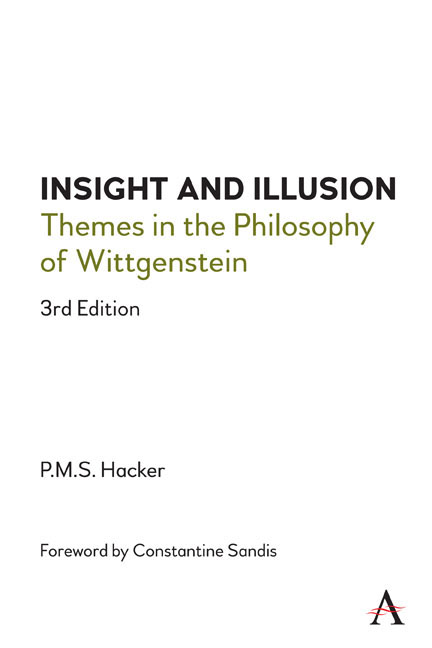Book contents
- Frontmatter
- Dedication
- Contents
- FOREWORD
- PREFACE TO THE REVISED EDITION
- PREFACE TO THE FIRST EDITION
- LIST OF ABBREVIATIONS
- I WITTGENSTEIN’S EARLY CONCEPTION OF PHILOSOPHY
- II THE DIALOGUE WITH FREGE AND RUSSELL
- III MEANING, METAPHYSICS, AND THE MIND
- IV EMPIRICAL REALISM AND TRANSCENDENTAL SOLIPSISM
- V DISINTEGRATION AND RECONSTRUCTION
- VI WITTGENSTEIN’S LATER CONCEPTION OF PHILOSOPHY
- VII METAPHYSICS AS THE SHADOW OF GRAMMAR
- VIII THE REFUTATION OF SOLIPSISM
- IX PRIVATE LINGUISTS AND PUBLIC SPEAKERS
- X ‘A CLOUD OF PHILOSOPHY CONDENSED INTO A DROP OF GRAMMAR’
- XI CRITERIA, REALISM AND ANTI-REALISM
- INDEX
V - DISINTEGRATION AND RECONSTRUCTION
Published online by Cambridge University Press: 24 February 2022
- Frontmatter
- Dedication
- Contents
- FOREWORD
- PREFACE TO THE REVISED EDITION
- PREFACE TO THE FIRST EDITION
- LIST OF ABBREVIATIONS
- I WITTGENSTEIN’S EARLY CONCEPTION OF PHILOSOPHY
- II THE DIALOGUE WITH FREGE AND RUSSELL
- III MEANING, METAPHYSICS, AND THE MIND
- IV EMPIRICAL REALISM AND TRANSCENDENTAL SOLIPSISM
- V DISINTEGRATION AND RECONSTRUCTION
- VI WITTGENSTEIN’S LATER CONCEPTION OF PHILOSOPHY
- VII METAPHYSICS AS THE SHADOW OF GRAMMAR
- VIII THE REFUTATION OF SOLIPSISM
- IX PRIVATE LINGUISTS AND PUBLIC SPEAKERS
- X ‘A CLOUD OF PHILOSOPHY CONDENSED INTO A DROP OF GRAMMAR’
- XI CRITERIA, REALISM AND ANTI-REALISM
- INDEX
Summary
The Colour-Exclusion Problem
The philosophy expounded in the Tractatusseemed to Wittgenstein to contain at least the blueprint for the solution or dissolution of all the problems of philosophy. Between the completion of the work in 1918 and 1929, Wittgenstein abandoned philosophical research. His task subsequent to his return to philosophy in 1929 involved the pursuit of two general aims. The critical and destructive task concerned the dismantling of most of the Tractatusphilosophy, and a detailed probing into the faults inherent in the Tractatuspicture of language. The positive and constructive object was to rebuild an equally comprehensive set of answers to a similar array of philosophical problems. This chapter is concerned first with the disintegration of the Tractatusphilosophy, and secondly with the general direction of the reconstruction in the 1930s.
With the qualifications implicit or explicit in the last two chapters, the Tractatusis a well-integrated philosophy. It is thus plausible to suppose that one could begin dismantling the structure from more than one point. For Wittgenstein himself, however, the weakness became exposed at what might appear a matter of detail, namely the mutual exclusion of determinates of a dcterminable. The colour-exclusion problem was introduced in the Tractatus,6.3751 to exemplify the contention that all necessity is logical necessity. Appearances notwithstanding, the impossibility of the simultaneous presence of two colours at the same place is not a synthetic a priori truth, but a logical truth. The claim that ‘Ais red and Ais blue’ is contradictory (where ‘A’refers to a point in the visual field at a given time) implies, in the Tractatussystem, that the two conjuncts are not elementary propositions and that ‘red’ and ‘blue’ are not names of simples. For elementary propositions are logically independent, hence their conjunction cannot be contradictory. The programme implicit in 6.3751 was to show that when ‘Ais red’ is fully analysed into its constituents, its truth will perspicuously entail that Ais not blue, i f statements of degree were analysable—as I used to think', Wittgenstein explained later (RLF, pp. 168 f.) ‘we could explain this contradiction by saying that the colour Rcontains all degrees of R and none of B and that the colour B contains all degrees of B and none of R.'
- Type
- Chapter
- Information
- Insight and IllusionThemes in the Philosophy of Wittgenstein, pp. 108 - 145Publisher: Anthem PressPrint publication year: 2021

